Search Result
Results for "
caspases-8
" in MedChemExpress (MCE) Product Catalog:
| Cat. No. |
Product Name |
Target |
Research Areas |
Chemical Structure |
-
- HY-120833
-
|
|
Caspase
|
Others
|
|
Ac-Ile-Glu-Thr-Asp-pNA is a substrate for caspase-8. Caspase-8 binds to and cleaves the Ile-Glu-Thr-Asp (IETD) peptide sequence to release p-nitroalinide, which can be quantified by colorimetric detection at 405 nm as a measure of enzyme activity .
|
-
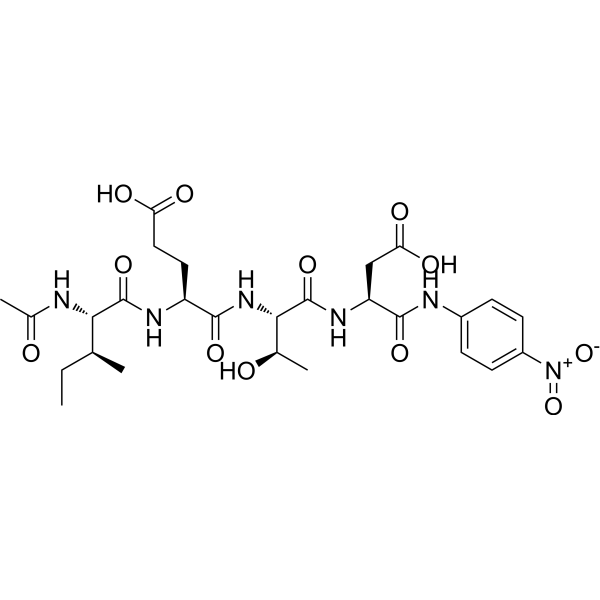
-
- HY-P4222
-
|
Caspase-8-IN-1
|
Caspase
|
Others
|
|
IETD-CHO (Caspase-8-IN-1) is a potent caspase-8 inhibitor .
|
-
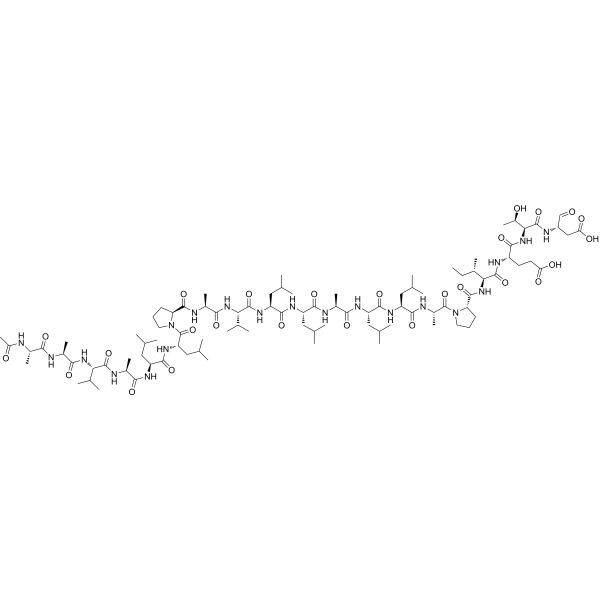
-
- HY-P4222A
-
|
|
Caspase
|
Others
|
|
IETD-CHO TFA (Caspase-8-IN-1) is a potent caspase-8 inhibitor .
|
-

-
- HY-P3362
-
|
|
Fluorescent Dye
|
Others
|
|
Ac-IETD-AMC is a fluorogenic caspase-8/granzyme B substrate containing the acetyl (Ac) moiety. Ac-IETD-AMC is frequently used to measure caspase-8 activity .
|
-
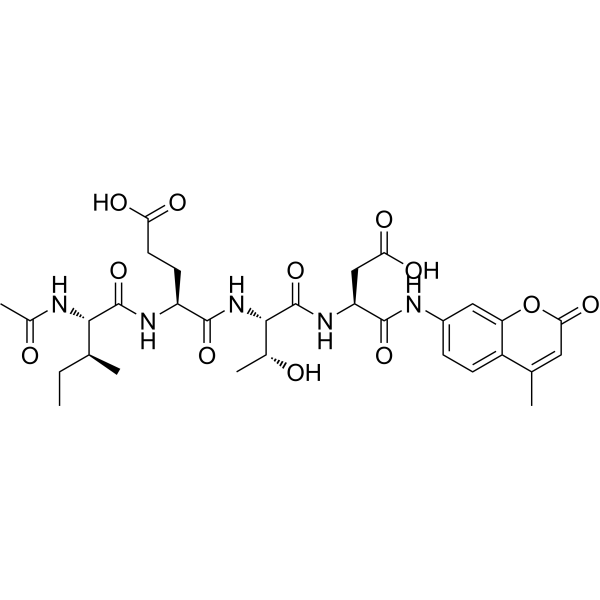
-
- HY-P2620
-
|
|
Fluorescent Dye
|
Metabolic Disease
Cancer
|
|
Ac-LETD-AFC is a caspase-8 fluorogenic substrate. Ac-LETD-AFC can measure caspase-8 fluorogenic activity and can be used for the research of cancer cell apoptosis and oxidative stress metabolism .
|
-
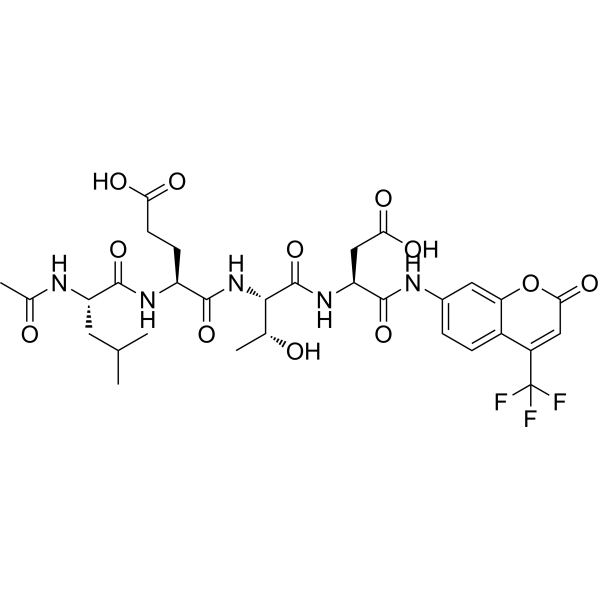
-
- HY-P10001
-
|
Z-Ile-Glu-Thr-Asp-pNA
|
Caspase
|
Cancer
|
|
Z-IETD-pNA (Z-Ile-Glu-Thr-Asp-pNA) is a colorimetric caspase-8 and granzyme B substrate. Z-IETD-pNA is hydrlyzed by caspase 8 to generate pNA .
|
-
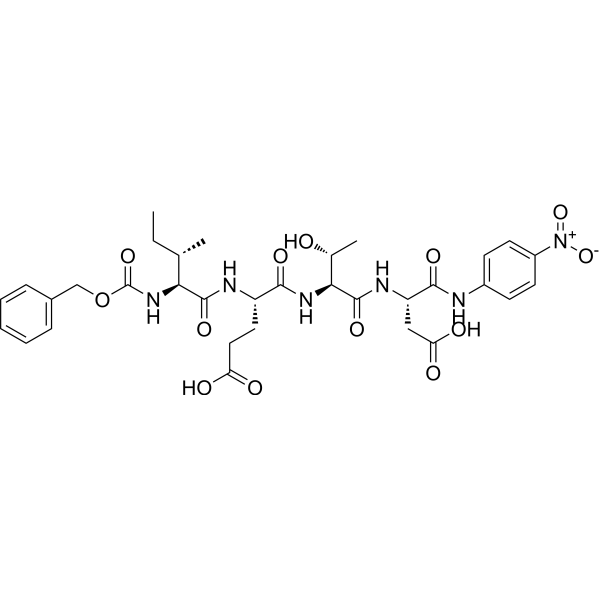
-
- HY-P2208
-
|
|
Fluorescent Dye
|
Cancer
|
|
Z-IETD-AFC, a specific fluorescence substrate, can be used to determine the caspase-8 catalytic activity .
|
-

-
- HY-P5830
-
|
|
Caspase
|
Others
|
|
Biotin-DEVD-CHO can be used for affinity labeling of Caspase-8 following in vitro caspase cleavage .
|
-
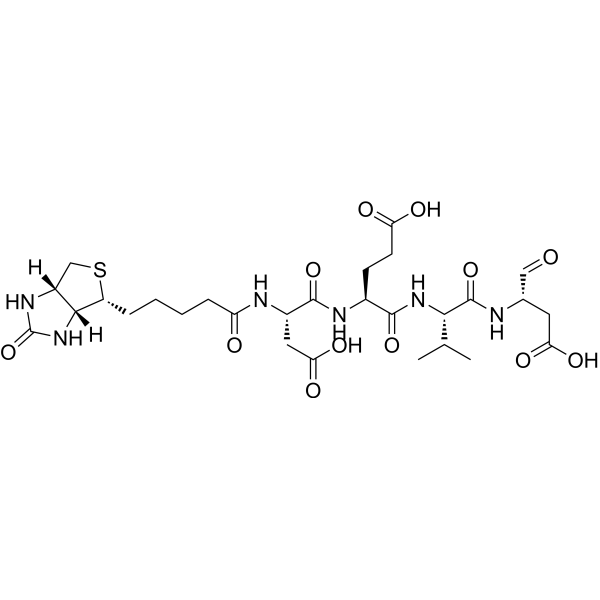
-
- HY-P1169
-
|
|
Caspase
|
Others
|
|
Ac-IETD-AFC is a fluorogenic substrate of caspase-8, caspase-3, caspase-10, and granzyme B .
|
-
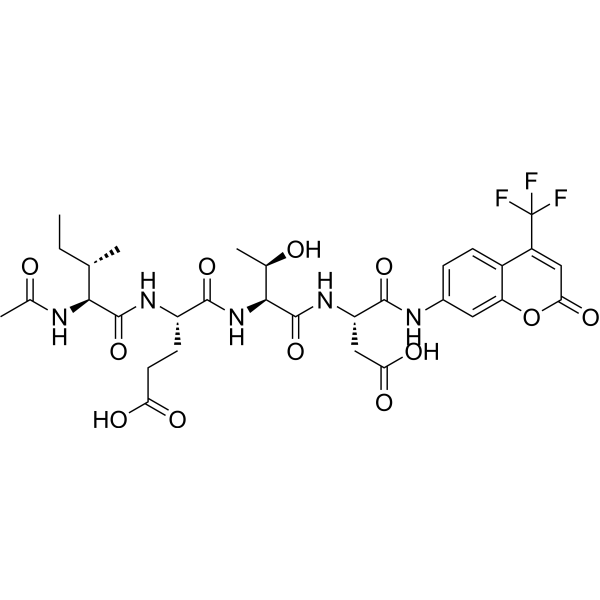
-
- HY-N0605
-
|
20(S)-Ginsenoside Rh2; 20(S)-Rh2; Ginsenoside-Rh2
|
Caspase
Apoptosis
Endogenous Metabolite
|
Cancer
|
|
Ginsenoside Rh2 induces the activation of caspase-8 and caspase-9. Ginsenoside Rh2 induces cancer cell apoptosis in a multi-path manner.
|
-
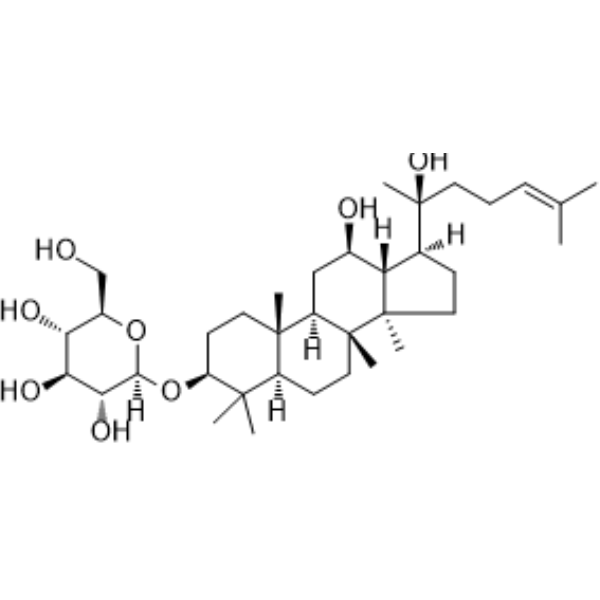
-
- HY-138203
-
|
|
Caspase
Apoptosis
|
Cancer
|
|
Z-LE(OMe)TD(OMe)-FMK is a selective caspase-8 inhibitor. Z-LE(OMe)TD(OMe)-FMK can inhibit cell apoptosis .
|
-
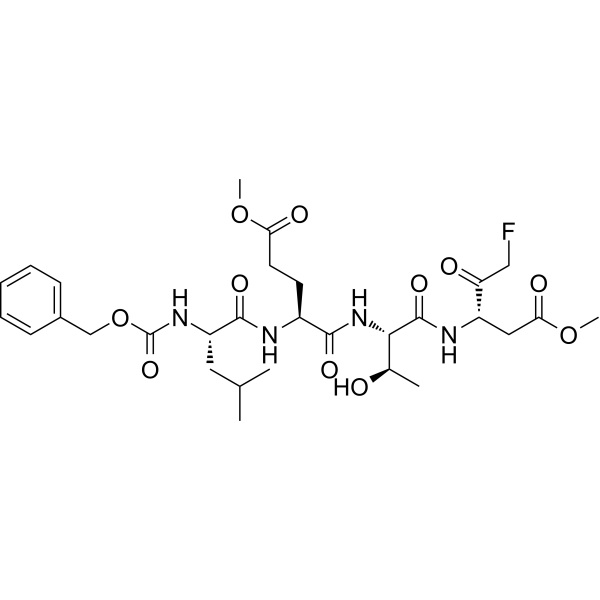
-
- HY-16591
-
|
TL32711
|
IAP
Apoptosis
HIV
|
Cancer
|
|
Birinapant (TL32711), a bivalent Smac mimetic, is a potent antagonist for XIAP and cIAP1 with Kds of 45 nM and less than 1 nM, respectively. Birinapant (TL32711) induces the autoubiquitylation and proteasomal degradation of cIAP1 and cIAP2 in intact cells, which results in formation of a RIPK1: caspase-8 complex, caspase-8 activation, and induction of tumor cell death. Birinapant (TL32711) targets TRAF2-associated cIAPs and abrogates TNF-induced NF-κB activation.
|
-

-
- HY-101297
-
Z-IETD-FMK
Maximum Cited Publications
37 Publications Verification
Z-IE(OMe)TD(OMe)-FMK
|
Caspase
|
Cancer
|
|
Z-IETD-FMK (Z-IE(OMe)TD(OMe)-FMK) is a selective and cell permeable caspase-8 inhibitor . Z-IETD-FMK is also a granzyme B inhibitor .
|
-

-
- HY-N6777
-
|
|
Caspase
Bacterial
Apoptosis
Antibiotic
|
Infection
Cancer
|
|
Penicillic acid is a polyketide mycotoxin produced by several species of Aspergillus and Penicillium. Penicillic acid exhibits cytotoxicity in rat alveolar macrophages (AM) in vitro. Penicillic acid inhibits Fas ligand-induced apoptosis by blocking self-processing of caspase-8 .
|
-

-
- HY-N0605R
-
|
20(S)-Ginsenoside Rh2(Standard); 20(S)-Rh2(Standard); Ginsenoside-Rh2 (Standard)
|
Caspase
Apoptosis
Endogenous Metabolite
|
Cancer
|
|
Ginsenoside Rh2 (Standard) is the analytical standard of Ginsenoside Rh2. This product is intended for research and analytical applications. Ginsenoside Rh2 induces the activation of caspase-8 and caspase-9. Ginsenoside Rh2 induces cancer cell apoptosis in a multi-path manner.
|
-
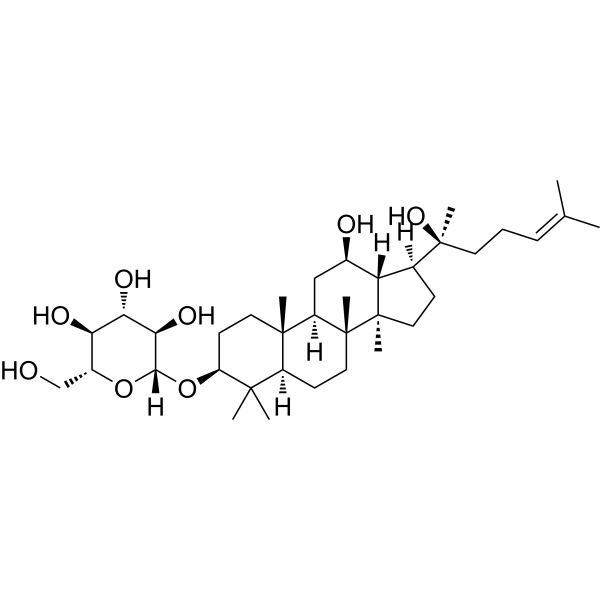
-
- HY-113963
-
|
|
Apoptosis
|
Cancer
|
|
Ac-?IETD-?CHO is a potent, reversible inhibitor of granzyme B and caspase-8. Ac-?IETD-?CHO inhibits Fas-mediated apoptotic cell death, hemorrhage, and liver failure. Ac-?IETD-?CHO also inhibits cytotoxic T lymphocytes induced cell death .
|
-
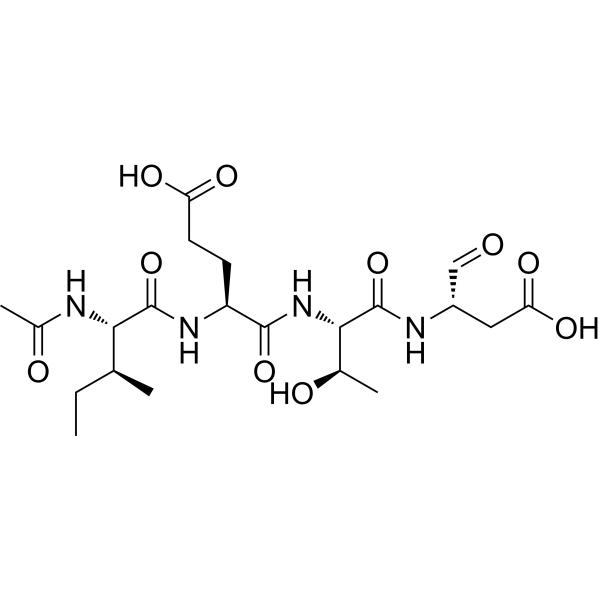
-
- HY-121320
-
|
|
Caspase
Apoptosis
|
Cancer
|
|
Raptinal, a agent that directly activates caspase-3, initiates intrinsic pathway caspase-dependent apoptosis. Raptinal is able to rapidly induce cancer cell death by directly activating the effector caspase-3, bypassing the activation of initiator caspase-8 and caspase-9 .
|
-

-
- HY-N9942
-
|
|
Apoptosis
Autophagy
|
Cancer
|
|
Physalin A is a withanolide isolated from Physalis alkekengi var. franchetii. Physalin A induces apoptosis associated with up-regulation of caspase-3 and caspase-8 expression. Physalin A induces autophagy, found to antagonize apoptosis in HT1080 cells. Physalin A has the potential for the research of cancer disease .
|
-

-
- HY-N0817
-
|
|
Apoptosis
Autophagy
Bacterial
|
Inflammation/Immunology
Cancer
|
|
Polyphyllin G is isolated from the rhizomes of Paris yunnanensis, with antimicrobial and anticancer activity. Polyphyllin G prevents the growth of both Gram-positive and Gram-negative bacteria with minimum inhibitory concentrations (MICs) .
Polyphyllin G induces apoptosis dependent on the activations of caspase-8, -3, and -9, induces autophagy .
|
-

-
- HY-W010201
-
|
(±)-Citronellol; (±)-β-Citronellol
|
Reactive Oxygen Species
|
Cancer
|
|
Citronellol ((±)-Citronellol) is a monoterpene Pelargonium graveolens. Citronellol ((±)-Citronellol) induces necroptosis of cancer cell via up-regulating TNF-α, RIP1/RIP3 activities, down-regulating caspase-3/caspase-8 activities and increasing ROS (reactive oxygen species) accumulation .
|
-
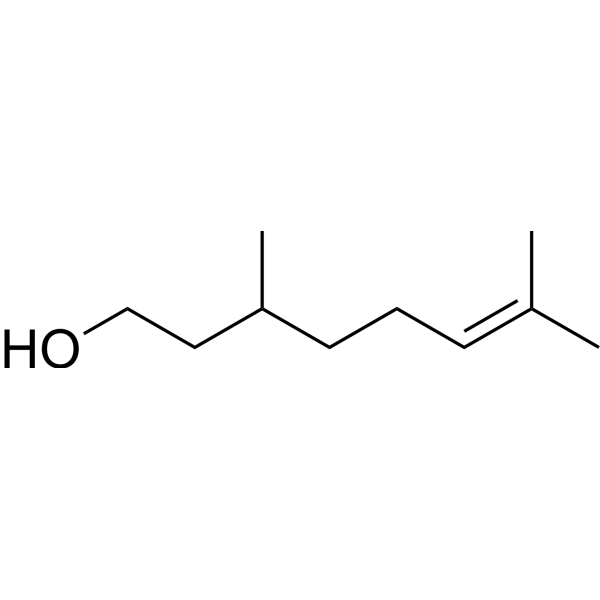
-
- HY-P5834
-
-
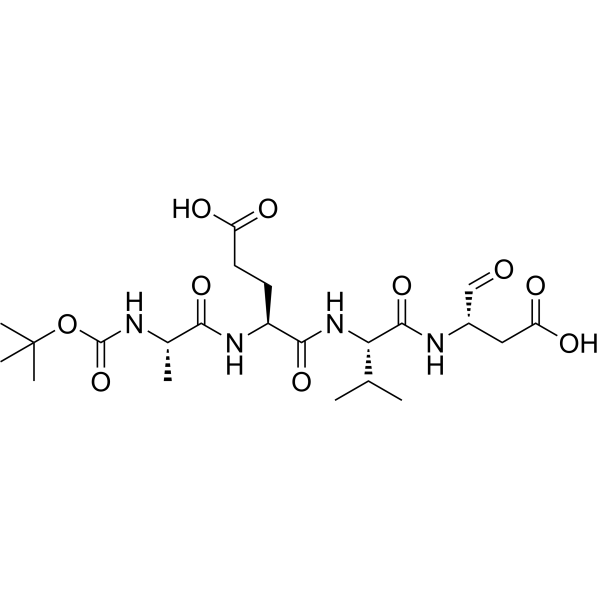
-
- HY-W010201R
-
|
(±)-Citronellol (Standard); (±)-β-Citronellol (Standard)
|
Reactive Oxygen Species
|
Cancer
|
|
Citronellol (Standard) is the analytical standard of Citronellol. This product is intended for research and analytical applications. Citronellol ((±)-Citronellol) is a monoterpene Pelargonium graveolens. Citronellol ((±)-Citronellol) induces necroptosis of cancer cell via up-regulating TNF-α, RIP1/RIP3 activities, down-regulating caspase-3/caspase-8 activities and increasing ROS (reactive oxygen species) accumulation .
|
-
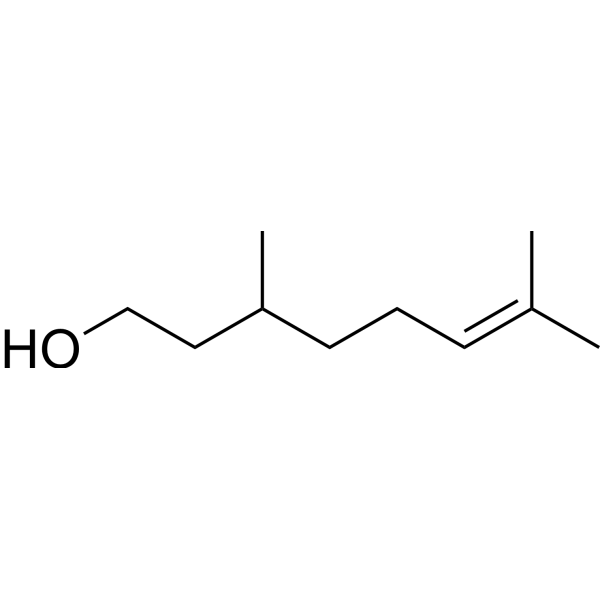
-
- HY-P3560
-
|
TV 4710
|
Apoptosis
|
Inflammation/Immunology
|
|
Edratide (TV 4710) is a synthetic peptide of 19 amino acid based on the complementarity-determining region 1 (CDR1) of a human anti-DNA antibody that expresses a major idiotype denoted 16/6 Id. Edratide reduces the rates of apoptosis (Apoptosis) and down-regulates of caspase-8 and caspase-3, up-regulates Bcl-xL. Edratide has the potential for the research of systemic lupus erythematosus (SLE) .
|
-
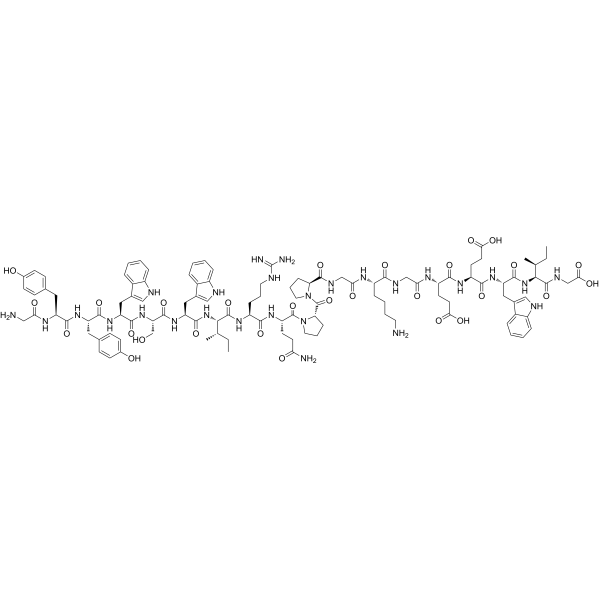
-
- HY-P10082
-
|
|
Caspase
|
Others
|
|
Ac-VETD-AMC is a synthetic peptide substrate for caspase 8. Ac-VETD-AMC also has potential to assess functional activity of recombinant phytaspase .
|
-
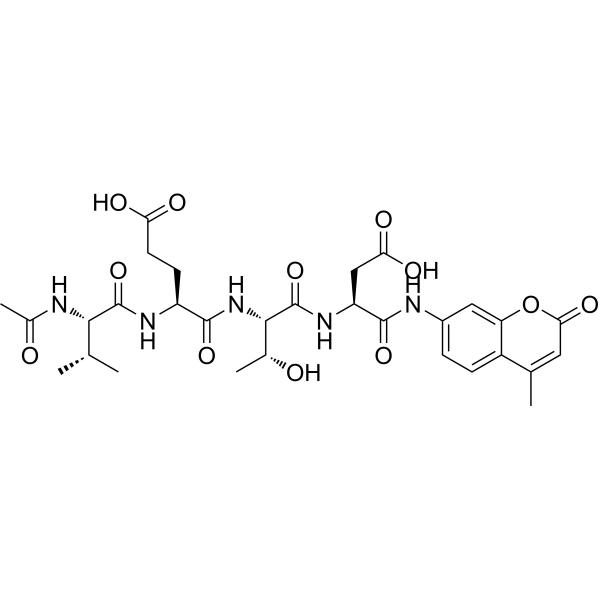
-
- HY-N0674A
-
|
13-Methylpalmatine chloride
|
Bcl-2 Family
Caspase
PARP
p38 MAPK
Parasite
Autophagy
|
Infection
Cancer
|
|
Dehydrocorydaline chloride (13-Methylpalmatine chloride) is an alkaloid that regulates protein expression of Bax, Bcl-2; activates caspase-7, caspase-8, and inactivates PARP . Dehydrocorydaline chloride elevates p38 MAPK activation. Anti-inflammatory and anti-cancer activities . Dehydrocorydaline chloride shows strong anti-malarial effects (IC50 =38 nM), and low cytotoxicity (cell viability > 90%) using P. falciparum 3D7 strain .
|
-
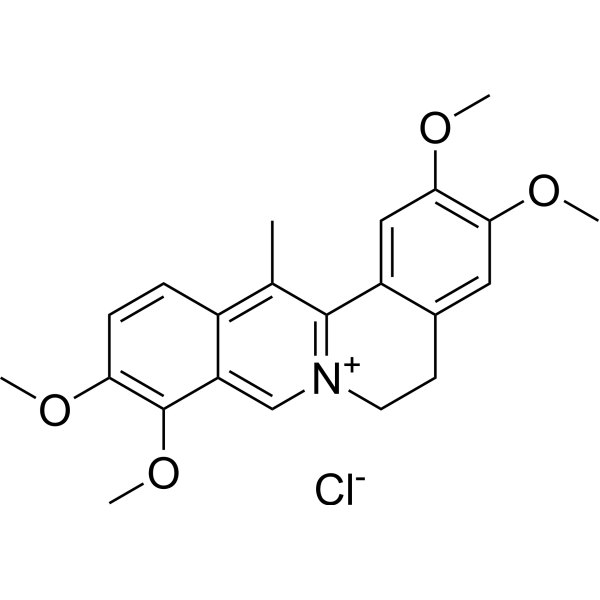
-
- HY-B0493
-
|
|
Chloride Channel
COX
|
Inflammation/Immunology
|
|
Niflumic acid is a calcium-activated chloride channel blocker and COX-2 inhibitor with the IC50 value of 100 nM. Niflumic acid induces apoptosis through caspase-8/Bid/Bax pathway in lung cancer cells. Niflumic acide exhibits anti-tumor activity by affecting the expression of ERK1/2 and the activity of MMP2 and MMP9. Niflumic acid has orally bioactivity. Niflumic acid acts on rheumatoid arthritis [8].
|
-
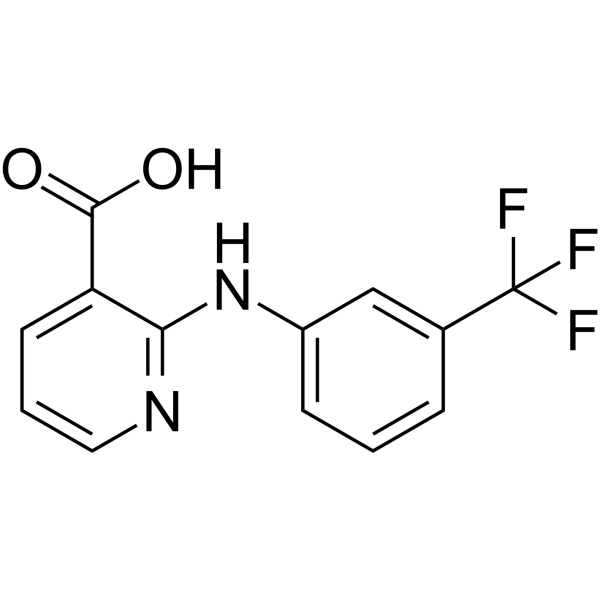
-
- HY-N0674
-
|
13-Methylpalmatine
|
Bcl-2 Family
Caspase
PARP
p38 MAPK
Parasite
Autophagy
|
Infection
Cancer
|
|
Dehydrocorydaline (13-Methylpalmatine) is an alkaloid that regulates protein expression of Bax, Bcl-2; activates caspase-7, caspase-8, and inactivates PARP . Dehydrocorydaline elevates p38 MAPK activation. Anti-inflammatory and anti-cancer activities . Dehydrocorydaline shows strong anti-malarial effects (IC50=38 nM), and low cytotoxicity (cell viability > 90%) using P. falciparum 3D7 strain .
|
-

-
- HY-N0674B
-
|
13-Methylpalmatine (hydroxyl)
|
Bcl-2 Family
Caspase
PARP
p38 MAPK
Parasite
Autophagy
|
Infection
Inflammation/Immunology
Cancer
|
|
Dehydrocorydaline (13-Methylpalmatine) hydroxyl is an alkaloid that regulates protein expression of Bax, Bcl-2; activates caspase-7, caspase-8, and inactivates PARP. Dehydrocorydaline hydroxyl elevates p38 MAPK activation. Anti-inflammatory and anti-cancer activities. Dehydrocorydaline hydroxyl shows strong anti-malarial effects (IC50=38 nM), and low cytotoxicity (cell viability > 90%) using P. falciparum 3D7 strain.
|
-
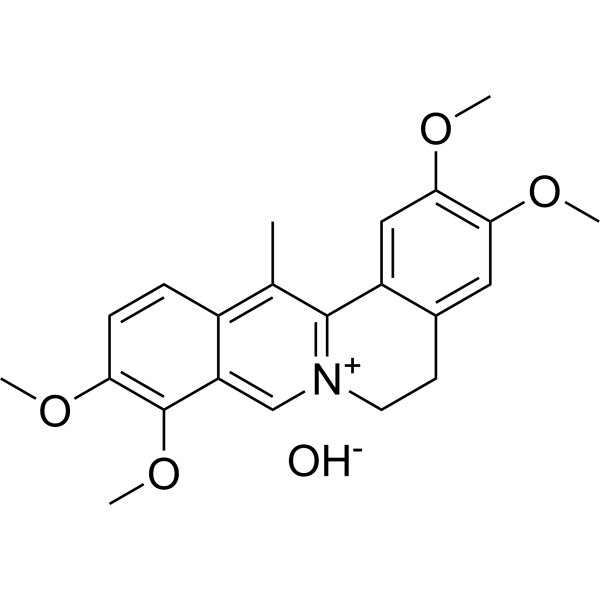
-
- HY-N4238
-
|
13-Methylpalmatine nitrate
|
Bcl-2 Family
Caspase
PARP
p38 MAPK
Parasite
Autophagy
|
Infection
Cancer
|
|
Dehydrocorydaline nitrate (13-Methylpalmatine nitrate) is an alkaloid. Dehydrocorydaline regulates protein expression of Bax, Bcl-2; activates caspase-7, caspase-8, and inactivates PARP . Dehydrocorydaline nitrate elevates p38 MAPK activation. Anti-inflammatory and anti-cancer activities. . Dehydrocorydaline nitrate shows strong anti-malarial effects (IC50 =38 nM), and low cytotoxicity (cell viability > 90%) using P. falciparum 3D7 strain .
|
-
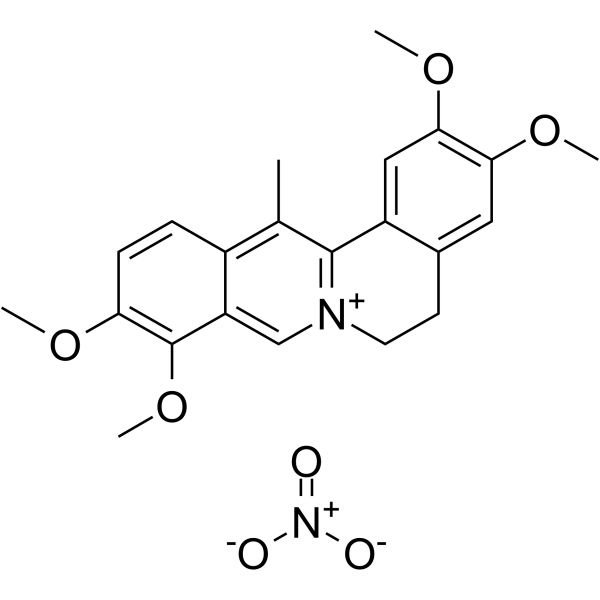
-
- HY-P10146
-
|
|
Caspase
|
Cancer
|
|
Ac-LETD-CHO
is a caspases 8 inhibitor. Ac-LETD-CHO has specific inhibition to casp-8 with
an IC50 value of 6.71 nM. Ac-LETD-CHO
can be used for the research of anticancer .
|
-
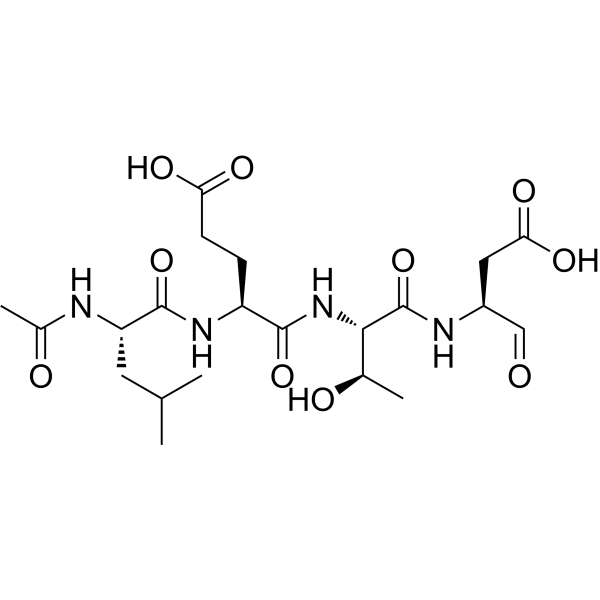
-
- HY-12290
-
|
RGDS peptide; Fibronectin tetrapeptide
|
Integrin
|
Inflammation/Immunology
|
|
Arg-Gly-Asp-Ser is an integrin binding sequence that inhibits integrin receptor function. Arg-Gly-Asp-Ser directly and specifically bind pro-caspase-8, pro-caspase-9 and pro-caspase-3, while it does not bind pro-caspase-1.
|
-
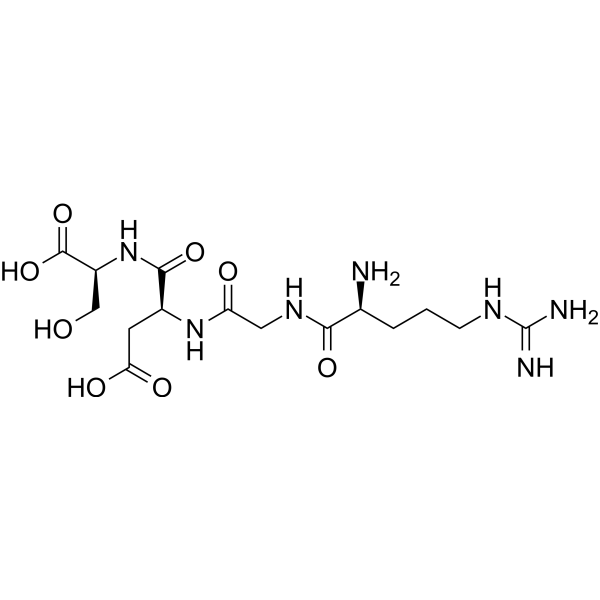
-
- HY-12290A
-
|
RGDS peptide TFA; Fibronectin tetrapeptide TFA
|
Integrin
|
Inflammation/Immunology
|
|
Arg-Gly-Asp-Ser (TFA) is an integrin binding sequence that inhibits integrin receptor function. Arg-Gly-Asp-Ser (TFA) directly and specifically bind pro-caspase-8, pro-caspase-9 and pro-caspase-3, while it does not bind pro-caspase-1 .
|
-
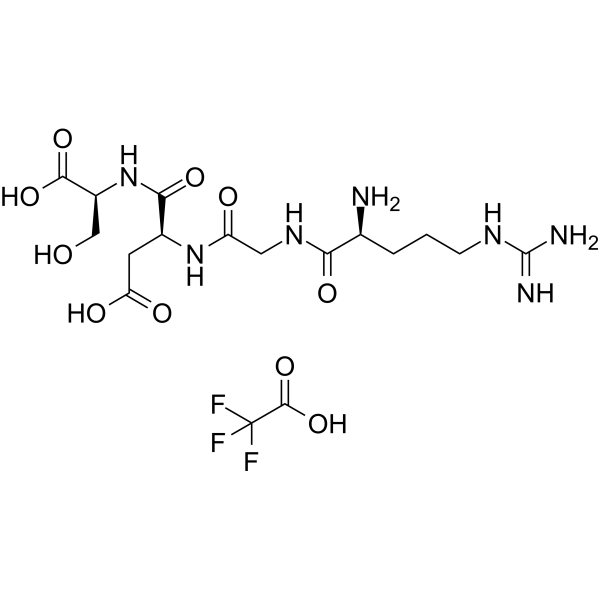
-
- HY-106789
-
|
CS-684
|
Bacterial
|
Infection
Inflammation/Immunology
Cancer
|
|
Plaunotol is an orally active acyclic diterpene alcohol. Plaunotol has antibacterial activity against Helicobacter pylori which causes peptic ulcer . Plaunotol inhibits tumor angiogenesis and cell proliferation. Plaunotol induces apoptosis by activation of caspase 8 and caspase 9 pathways. Plaunotol is a potential anticancer agent against colon cancer .
|
-

-
- HY-P3779
-
|
Aβ(17-42)
|
Apoptosis
|
Neurological Disease
|
|
Amyloid 17-42 (Aβ(17-42)) is a major constituent of diffuse plaques in Alzheimer's disease and cerebellar pre-amyloid in Down's syndrome, derived by alpha- and gamma-secretase cleavage of the amyloid precursor protein (APP). Amyloid 17-42 can induce neuronal apoptosis via a Fas-like/caspase-8 activation pathway .
|
-

-
- HY-147646
-
|
|
CDK
Apoptosis
|
Cancer
|
|
CDK1/Cyc B-IN-1 (Compound 5) is a selective CDK1/Cyc B complex inhibitor with an IC50 of 97 nM. CDK1/Cyc B-IN-1 triggers apoptosis and G2/M cell cycle arrest. CDK1/Cyc B-IN-1 shows broad-spectrum cytotoxic action against cancer cell lines .
|
-

-
- HY-149523
-
|
|
Apoptosis
NO Synthase
Caspase
|
Inflammation/Immunology
Cancer
|
|
Anticancer agent 157 (compound 15) is a NO inhibitor (IC50=0.62 μg/mL) with anti-inflammatory and anticancer activities. Anticancer agent 157 can bind to iNOS (inducible NO synthase) and caspase 8, causing nuclear fragmentation and chromatin condensation, inducing apoptosis. Anticancer agent 157 inhibits HT29 colon cancer cells (IC50=2.45 μg/mL), Hep-G2 liver cancer cells (IC50=3.25 μg/mL), and B16-F10 murine melanoma cells (IC50=3.84 μg/mL) .
|
-

| Cat. No. |
Product Name |
Type |
| Cat. No. |
Product Name |
Target |
Research Area |
-
- HY-120833
-
|
|
Caspase
|
Others
|
|
Ac-Ile-Glu-Thr-Asp-pNA is a substrate for caspase-8. Caspase-8 binds to and cleaves the Ile-Glu-Thr-Asp (IETD) peptide sequence to release p-nitroalinide, which can be quantified by colorimetric detection at 405 nm as a measure of enzyme activity .
|
-
- HY-P4222
-
|
Caspase-8-IN-1
|
Caspase
|
Others
|
|
IETD-CHO (Caspase-8-IN-1) is a potent caspase-8 inhibitor .
|
-
- HY-P4222A
-
|
|
Caspase
|
Others
|
|
IETD-CHO TFA (Caspase-8-IN-1) is a potent caspase-8 inhibitor .
|
-
- HY-P3362
-
|
|
Fluorescent Dye
|
Others
|
|
Ac-IETD-AMC is a fluorogenic caspase-8/granzyme B substrate containing the acetyl (Ac) moiety. Ac-IETD-AMC is frequently used to measure caspase-8 activity .
|
-
- HY-P2620
-
|
|
Fluorescent Dye
|
Metabolic Disease
Cancer
|
|
Ac-LETD-AFC is a caspase-8 fluorogenic substrate. Ac-LETD-AFC can measure caspase-8 fluorogenic activity and can be used for the research of cancer cell apoptosis and oxidative stress metabolism .
|
-
- HY-P10001
-
|
Z-Ile-Glu-Thr-Asp-pNA
|
Caspase
|
Cancer
|
|
Z-IETD-pNA (Z-Ile-Glu-Thr-Asp-pNA) is a colorimetric caspase-8 and granzyme B substrate. Z-IETD-pNA is hydrlyzed by caspase 8 to generate pNA .
|
-
- HY-P2208
-
|
|
Fluorescent Dye
|
Cancer
|
|
Z-IETD-AFC, a specific fluorescence substrate, can be used to determine the caspase-8 catalytic activity .
|
-
- HY-P5830
-
|
|
Caspase
|
Others
|
|
Biotin-DEVD-CHO can be used for affinity labeling of Caspase-8 following in vitro caspase cleavage .
|
-
- HY-P1169
-
|
|
Caspase
|
Others
|
|
Ac-IETD-AFC is a fluorogenic substrate of caspase-8, caspase-3, caspase-10, and granzyme B .
|
-
- HY-138203
-
|
|
Caspase
Apoptosis
|
Cancer
|
|
Z-LE(OMe)TD(OMe)-FMK is a selective caspase-8 inhibitor. Z-LE(OMe)TD(OMe)-FMK can inhibit cell apoptosis .
|
-
- HY-101297
-
Z-IETD-FMK
Maximum Cited Publications
37 Publications Verification
Z-IE(OMe)TD(OMe)-FMK
|
Caspase
|
Cancer
|
|
Z-IETD-FMK (Z-IE(OMe)TD(OMe)-FMK) is a selective and cell permeable caspase-8 inhibitor . Z-IETD-FMK is also a granzyme B inhibitor .
|
-
- HY-113963
-
|
|
Apoptosis
|
Cancer
|
|
Ac-?IETD-?CHO is a potent, reversible inhibitor of granzyme B and caspase-8. Ac-?IETD-?CHO inhibits Fas-mediated apoptotic cell death, hemorrhage, and liver failure. Ac-?IETD-?CHO also inhibits cytotoxic T lymphocytes induced cell death .
|
-
- HY-P5834
-
-
- HY-P3560
-
|
TV 4710
|
Apoptosis
|
Inflammation/Immunology
|
|
Edratide (TV 4710) is a synthetic peptide of 19 amino acid based on the complementarity-determining region 1 (CDR1) of a human anti-DNA antibody that expresses a major idiotype denoted 16/6 Id. Edratide reduces the rates of apoptosis (Apoptosis) and down-regulates of caspase-8 and caspase-3, up-regulates Bcl-xL. Edratide has the potential for the research of systemic lupus erythematosus (SLE) .
|
-
- HY-P10082
-
|
|
Caspase
|
Others
|
|
Ac-VETD-AMC is a synthetic peptide substrate for caspase 8. Ac-VETD-AMC also has potential to assess functional activity of recombinant phytaspase .
|
-
- HY-P10146
-
|
|
Caspase
|
Cancer
|
|
Ac-LETD-CHO
is a caspases 8 inhibitor. Ac-LETD-CHO has specific inhibition to casp-8 with
an IC50 value of 6.71 nM. Ac-LETD-CHO
can be used for the research of anticancer .
|
-
- HY-12290
-
|
RGDS peptide; Fibronectin tetrapeptide
|
Integrin
|
Inflammation/Immunology
|
|
Arg-Gly-Asp-Ser is an integrin binding sequence that inhibits integrin receptor function. Arg-Gly-Asp-Ser directly and specifically bind pro-caspase-8, pro-caspase-9 and pro-caspase-3, while it does not bind pro-caspase-1.
|
-
- HY-12290A
-
|
RGDS peptide TFA; Fibronectin tetrapeptide TFA
|
Integrin
|
Inflammation/Immunology
|
|
Arg-Gly-Asp-Ser (TFA) is an integrin binding sequence that inhibits integrin receptor function. Arg-Gly-Asp-Ser (TFA) directly and specifically bind pro-caspase-8, pro-caspase-9 and pro-caspase-3, while it does not bind pro-caspase-1 .
|
-
- HY-P3779
-
|
Aβ(17-42)
|
Apoptosis
|
Neurological Disease
|
|
Amyloid 17-42 (Aβ(17-42)) is a major constituent of diffuse plaques in Alzheimer's disease and cerebellar pre-amyloid in Down's syndrome, derived by alpha- and gamma-secretase cleavage of the amyloid precursor protein (APP). Amyloid 17-42 can induce neuronal apoptosis via a Fas-like/caspase-8 activation pathway .
|
| Cat. No. |
Product Name |
Category |
Target |
Chemical Structure |
Your information is safe with us. * Required Fields.
Inquiry Information
- Product Name:
- Cat. No.:
- Quantity:
- MCE Japan Authorized Agent:












































